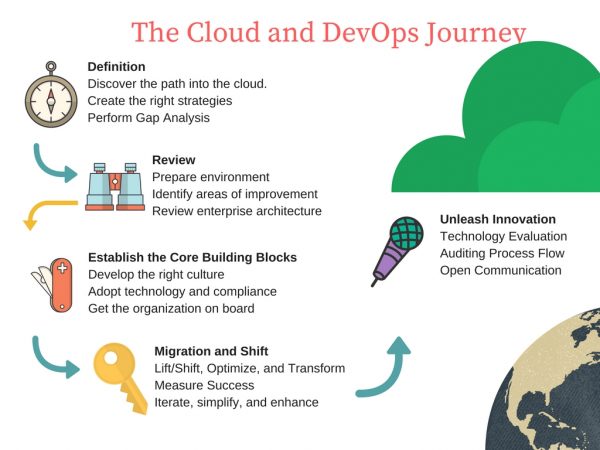
As organizations look forward into their crystal balls for 2017, more and more of our discussions with customers are tied to cloud /digital transformation. A key question which surfaces is how to best spend their budgets tied to cloud/digital transformation to get maximum ROI as well as help their organizations innovate faster.
We began the year hearing from RightScale in their annual State of the Cloud Survey, an industry overview of where professionals see their cloud efforts headed. As a whole, cloud has increased immensely in adoption, with 71% with workloads in hybrid cloud and 74% having adopted DevOps. Despite these high numbers however, the path to digital transformation is still a challenge. Roughly a quarter of those surveyed also indicated that managing their cloud had become a difficult task, a rise of nearly ten percent from the year before. In short, while cloud is the answer, the path to it is still fairly cloudy in of itself.
Here at Perficient, we speak to customers in a variety of industries on a weekly basis around challenges in the cloud. Similar to industry surveys, our conversations have netted similar results, with many searching for a path to transformation amid product selection and cultural change. As leaders in the industry, we seek to not only implement innovation, but also provide clarity in the journey. I would like to talk about some of those destinations along the journey in today’s blog.
Destination #1: Definition
The first step along the journey is definition, which requires the communication, benchmarking, and baselining of a cloud strategy. This work focuses on both organizational culture impact as well as technology, ensuring that both move at the same time in impacting the organization. Much of what is done in phases 1-3 are also included in the Innovation Lab, our 2-8 week program where we help organizations discover and plan out their cloud or DevOps needs.
In addition, organizational leaders must also perform gap analysis, or an assessment of existing technologies already as an asset. While moving to the cloud is an exciting proposition for today, some infrastructure can be moved later for a more gradual approach. Creating a checklist to match the above strategies ultimately results in an actionable roadmap that will guide the organization forward.
Destination #2: Review
Once the strategy has been created, it’s time to get organizational buy-in. While Cloud and DevOps may be viewed as a collection of technologies, their real impact lies in how they shift culture from a silo-driven organization to one of collaboration and communication. Thus, it’s important to:
- Identify improvement initiatives and review current infrastructure – Create and approve a roadmap as to what currently exists and what needs to be acquired over a period of time.
- Develop standards for people and culture – Gain buy-in and communicate with all employees regarding expectations and interests. Not everyone may like the change and it’s important to assess feedback on a continuous basis.
Destination #3: Establish the Core Building Blocks
Digital transformation cannot occur without the right core building blocks, which include software, infrastructure, and best practices. It’s important in this phase to include all aspects of the organization, including business, legal, and procurement so it’s clearly established what is a priority and what isn’t. In some of our work with our customers, we’ve developed what’s called a Center of Excellence to establish best practices and standard operating procedures that will endure long after our departure.
It’s also in this phase where you will decide what technology journey you’ll embark on to build the foundation of your digital transformation future including big data, analytics, and mobility. Depending on your industry, you may also have to follow strict compliance, security, and governance policies.
Destination #4: Migration and Shift
With everything now defined and standardized, the fun can begin. In the fourth destination, it’s all about execution and assessment. We describe these efforts as the 3 M’s:
- Migration – In this segment of the journey, you begin to lift and shift workloads, optimize, and transition operations into the cloud.
- Measure – Calculate the success of your cloud efforts. Ensure that you are seeing the efficiency gains intended with the cloud.
- Modify – Make any changes necessary within your strategy and your implementation. Gather continuous feedback in both simplifying and enhancing your strategy.
Destination #5: Unleash Innovation
Finally, you’re ready to unleash innovation and discover the benefits of digital transformation. In-line with DevOps, you’ll also be continuing to iterate and improve upon your culture and technology. Some ideas here include:
- Regular evaluations of the technology your organization is using.
- Surveys and open lines of communication for feedback regarding DevOps within the organization.
- Auditing to ensure that innovation processes remain simple and agile.
Learn More
Now you’re on your way to becoming an innovative, lean, and adaptive digital enterprise. With innovative cloud technologies from IBM , Amazon AWS, Pivotal , Microsoft , Docker and DevOps technologies from vendors like Urbancode, Sonatype, Cloudbees Jenkins , and our frameworks, accelerators, best practices , procedures, and philosophies in tow, you can compete in the global market while meeting the rising expectations of your customers.
We’ll be covering more of these philosophies in the next few blogs. If you’re just getting started on your Cloud and DevOps journey, reach out to us for more insight and consultation by sending us an email at sales@perficient.com. We look forward to hearing from you.
Learn more about our partnerships here.
